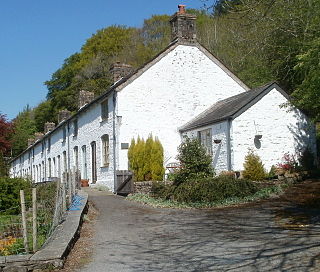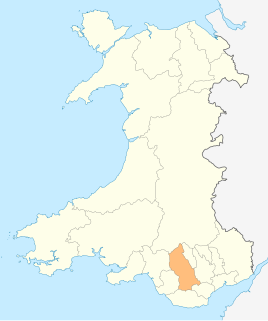
Powis Castle is a medieval castle, fortress and grand country house near Welshpool, in Powys, Wales. The seat of the Herbert family, Earls of Powis, the castle is known for its formal gardens and for its interiors, the former having been described as "the most important", and the latter "the most magnificent", in Wales. The castle and garden are under the care of the National Trust. Powis Castle is a Grade I listed building.

St Donat's Castle, St Donats, Wales, is a medieval castle in the Vale of Glamorgan, about 16 miles (26 km) to the west of Cardiff, and about 1+1⁄2 miles (2.4 km) to the west of Llantwit Major. Positioned on cliffs overlooking the Bristol Channel, the site has been occupied since the Iron Age, and was by tradition the home of the Celtic chieftain Caradog. The present castle's origins date from the 12th century when the de Haweys and later Peter de Stradling began its development. The Stradlings held the castle for four hundred years, until the death of Sir Thomas Stradling in a duel in 1738.

Fairwater is a community and suburb of Cwmbran in the county borough of Torfaen, in south east Wales, and was built by the Cwmbran Development Corporation between 1963 and 1966.

Cwmavon is a hamlet about 2 miles south of Blaenavon and 4 miles north of Pontypool. The hamlet is part of the community of Abersychan in the county borough of Torfaen in south east Wales, and is within the boundaries of the historic county of Monmouthshire.

Sir William Goscombe John was a prolific Welsh sculptor known for his many public memorials. As a sculptor, John developed a distinctive style of his own while respecting classical traditions and forms of sculpture. He gained national attention with statues of emminent Victorians in London and Cardiff and subsequently, after both the Second Boer War and World War I, created a large number of war memorials. These included the two large group works, The Response 1914 in Newcastle upon Tyne and the Port Sunlight War Memorial which are considered the finest sculptural ensembles on any British monument.
Pen y Clawdd Castle is a ditched mound with a double moat, roughly circular in shape, with a diameter of approximately 28m to 30m and about 2.4m high. The castle is in Llanvihangel Crucorney, about five miles to the north of Abergavenny, Monmouthshire, in south east Wales and lies between the Usk and Monnow rivers. The mound was designated a scheduled monument in 1950 and described as a defensive medieval motte.

Caerleon Endowed School, is a junior school that was built in 1724 from a bequest from Charles Williams. The school became part of the state education system in 1948 under the 1944 Education Act. The school was designated a Grade II* listed building in 1951.

St Pabo's Church, Llanbabo is a medieval church in Llanbabo, in Anglesey, North Wales. Much of the church dates to the 12th century, and it is regarded as a good example of a church of its period that has retained many aspects of its original fabric. The church houses a tombstone slab from the 14th century, depicting a king with crown and sceptre, bearing the name of Pabo Post Prydain, the reputed founder of the church. However, there is no evidence that Pabo, a 5th-century prince, lived in the area and the tradition that he founded the church has little supporting basis.

George Vaughan Maddox was a nineteenth-century British architect and builder, whose work was undertaken principally in the town of Monmouth, Wales, and in the wider county. Working mainly in a Neo-Classical style, his extensive output made a significant contribution to the Monmouth townscape. The architectural historian John Newman considers that Monmouth owes to Maddox "its particular architectural flavour. For two decades from the mid-1820s he put up a sequence of public buildings and private houses in the town, in a style deft, cultured, and only occasionally unresolved." The Market Hall and 1-6 Priory Street are considered his "most important projects".

LlanvihangelCourt, Llanvihangel Crucorney, is a Tudor country house in Monmouthshire, Wales. The architectural historian John Newman, in his Gwent/Monmouthshire volume of The Buildings of Wales series described the court as "the most impressive and richly decorated house of around 1600 in Monmouthshire". The origins of the house are medieval, with a traditional date of construction of 1471. The building was given its present appearance by a substantial enlargement and re-casing of circa 1600 by Rhys Morgan, of the family of the original owners. In the very early 17th century it was owned briefly by Edward Somerset, 4th Earl of Worcester.

Monmouthshire is a county and principal area of Wales. It borders Torfaen and Newport to the west; Herefordshire and Gloucestershire to the east; and Powys to the north. The largest town is Abergavenny, with other large settlements being Chepstow, Monmouth, and Usk. The present county was formed under the Local Government (Wales) Act 1994, and comprises some sixty percent of the historic county. Between 1974 and 1996, the county was known by the ancient title of Gwent, recalling the medieval Welsh kingdom. The county is 850 km2 in extent, with a population of 95,200 as of 2020.

Rhondda Cynon Taf is a county borough in South Wales. It is located to the north-west of Cardiff and covers an area of 424 km2 (164 sq mi). In 2020 the population was approximately 241,900.

Merthyr Tydfil County Borough is located in the historic county of Glamorgan in Wales and takes its name from its largest town. The county borough covers an area of 111 km2 (43 sq mi) and had a population of approximately 60,400 in 2020. There are ten structures on the list of twelve Grade II* listed buildings in Merthyr Tydfil. Two viaducts constructed as part of the Brecon and Merthyr Railway both straddle the borders of neighbouring communities so have separate designations for each of these locations.

Rhondda Cynon Taf is a county borough in South Wales. It is located to the north-west of Cardiff and covers an area of 424 km2 (164 sq mi). In 2020 the population was approximately 241,900.

St Illtyd's Church is a deconsecrated church in Llanhilleth, Blaenau Gwent, Wales. A Grade II* listed building, it is the oldest standing building in the county borough.

Gelligroes Mill is a water powered corn mill in Pontllanfraith, Caerphilly county borough, south Wales. It features an overshot wheel with a cast iron frame and wooden buckets. It was built around 1625, and much altered in its working life eventually falling into disuse in the late 1980s. It was soon restored and 1992. The mill was designated as a Grade II* listed building in 1962. It is believed to have been the last mill operating commercially in Monmouthshire.

Eglwys Newydd Church is an early 19th-century church which replaced a previous chapel of ease. The chapel of ease was originally at Trisant but was moved to this site around 1620 by the Herbert family, owners of the Hafod estate. The church was designated as a Grade II* listed building in 1964 for its historical connects with the Hafod estate and the quality of work of the remodelling in the 1930s.

Little Pitt Cottage is a medieval house in Llanarth, Monmouthshire, South Wales. It was designated a Grade II* listed building in 1956, its listing record describing it as a "fine and exceptionally intact timber-framed house".

Iscoyd Park is a three-storey redbrick country house in Wrexham County Borough, Wales. It has a slate roof built in the early 18th century. It was sold in 1737 to William Hanmer. The house and estate was then purchased by Philip Lake Godsal in 1843 and remains in the Godsal family to this day. Iscoyd was designated a Grade II* listed building in 1962 as a well-preserved country house. It supported by a range of 18th- and 19th-century service buildings including a park and gardens, outbuildings, coach house, corn house, kennels, laundry, piggery and stables. The dovecote has a pyramidal slate roof. The house is now run by Philip Langley Godsal and his wife Susie, who took over the house from his father Philip Caulfeild Godsal in 2009 and began a complete refurbishment. This was funded by operating as a wedding and events business but also remains the Godsal family home. Iscoyd Park has won various awards for the restoration of the house and outbuildings, including the Historic Houses Association and Sotheby’s Restoration Award, the Hudson’s Heritage Award for Best Wedding Venue, Hudson’s Heritage Award for Best Accommodation, Wales Gold Award for Best Services Accommodation, Bridebook’s Best National Wedding venue.

Penarth-fawr, Llanystumdwy, Gwynedd, Wales is a medieval hall house dating from the mid 15th century. Described in the Gwynedd Pevsner as "an important medieval hall house", Penarth-fawr is a Grade I listed building and a scheduled monument.


















